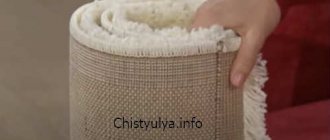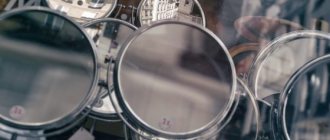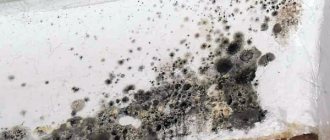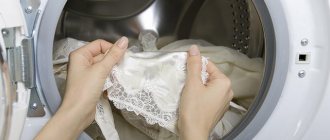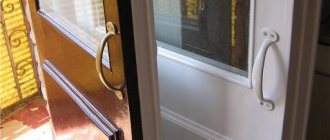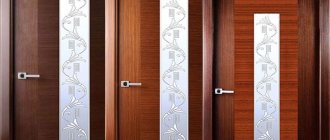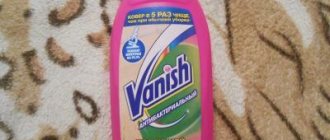A mirror is an element of interior design, which carries not only functional, but also decorative meaning. Mirror factories offer a full range of work on cutting mirrors, applying decorative designs (ornaments, patterns), placing a company logo or trademark. Decorative improvement of mirrors is a whole technological base, which includes the canons and rules of design, as well as decoration options. This article will discuss the chemical method of decorating mirrors.
Fig. 1 - “Removing old paint” No. 455 – used to clean the amalgam and protective paint layer from the back surface of mirrors.
Fig. 2 - “Washing off old paint” No. 178 - recommended for cleaning the protective paint layer (primer) from the back surface of mirrors.
Is it possible to repair old canvas?
The process of mirror restoration is very painstaking . Many experienced specialists in this field can not only collect the fragments, but also restore complete integrity. Dust from the inside, clouding, scratches, amalgam defects - all these damages can be eliminated independently using a minimum of tools that every home craftsman has.
But you should understand that in exceptional cases, inserting a new mirror into the frame is much more profitable than restoring the former beauty of the old canvas. Expensive and complex restoration is very rarely applied to museum exhibits that have historical value.
But if the mirror is slightly damaged, then it is stupid to throw it away, so in case of minor defects, it is advisable to restore the surface with your own hands .
If you use the right chemicals and abrasives, the mirror will shine like new. The main criterion is a correctly calculated dosage and a little effort.
Benefits of DIY restoration
Do-it-yourself mirror restoration has its own special advantages:
- It is not always possible to find a master in your city who can restore amalgam.
- Repairing the surface of a mirror will require patience and an investment of money, so turning to a specialist will require a large investment.
- It will take a lot of time to find a craftsman; in addition, during transportation, the interior item may break. If the damage is small, then it is easier to do everything yourself.
Problems with using mirrors
Modern mirrors have a complex multi-layer coating , which protects the amalgam from external influences and, in particular, from high humidity. Any mechanical contacts at the production stage, in stores, during transportation and installation can damage such protection, which significantly reduces the service life of the mirror surface.
Literally after two or three years of use, amalgam loses its reflective ability, becomes stained, and loses its original attractive appearance. Whereas all these problems can be avoided by properly caring for such interior items. The homeowner needs to handle the mirror carefully, avoiding mechanical damage, which is the main reason for the deterioration of the amalgam.
Repair
It is possible to restore a mirror surface even if cracks appear , and the repair can be carried out in such a way that no defects will be visible even with the naked eye. But it is better to carry out this process only with those mirrors that have historical value. Thus, it is not advisable to restore a simple household mirror on the wall - such repairs can be quite expensive.
Do-it-yourself restoration work is carried out only if it is justified, for example:
- minor scratches;
- small chips;
- abrasions;
- cracks in amalgam.
Let's look at some methods that can be used for recovery at home.
Tarnished surface
If a mirror hangs for a long time in a damp room or during prolonged use, its surface may become dull. If a similar situation occurs, then there is no need to throw away the piece of furniture; it can be returned to its original state, or rather polished.
This is a universal restoration tool that is used very often. The process will remove dark stains, minor scratches and abrasions from the surface. Polishing can be done completely or partially ; in some cases, preliminary polishing is allowed.
When polishing, it is important to choose the right special products and their dosage, otherwise the mirror surface may darken even more.
Scratched canvas
If there are scratches on the mirror, you can get rid of them by sanding the surface using abrasive materials. The process works as follows:
- remove the mirror from the frame;
- wash well with soapy water;
- clean surfaces with a degreasing chemical;
- take an abrasive material with optimal particle size, it all depends on the depth of the scratches;
- After this, polishing is used to add shine.
But when carrying out this operation, you need to be very careful, as you can wipe the canvas to holes and the mirror will be damaged.
Attention! If you are not confident in your skills, it is better to look for an experienced craftsman who will bring the piece of furniture into proper shape.
How to restore amalgam?
Amalgam is a metal layer that creates a reflective surface that can peel off or crack over time. This damage looks very unsightly - bald spots all over the surface.
It is worth immediately noting that the restoration of amalgam is a long and multi-stage process, which is carried out using foil, special tools and chemicals.
We invite you to watch a video of how amalgam restoration is carried out using foil:
Required materials and tools
There are two sets of tools and materials for restoration , for minor damage and significant defects. In the first case you will need:
- alcohol;
- water;
- napkins and soft rags;
- sponge;
- silicone sealant.
In the second you should prepare:
- brush;
- rags;
- glue for glass and metal;
- wiper;
- alcohol;
- tassels;
- foil;
- sponge and scissors.
Decorating a mirror
If the frame of the mirror is wooden and has lost its shine, you can update it by applying varnish of the required color. Or change the look of the mirror by decorating it with jewelry, shells, bamboo sticks or broken dishes. It all depends on the owner’s imagination.
Restoring mirrors is a rather painstaking task, the result of which should be the preservation of the original surface, especially if the mirror is antique.
Depending on the damage to the amalgam, different methods and materials for restoration will be used.
For minor damage, silicone sealant is used, and large areas are restored using foil and glue.
How to restore a mirror yourself
Experts note that any mirror must be carefully looked after, then its restoration will not be a problem for you. In a high-humidity room like a bathroom, you should purchase special reflective glass designed for use in such conditions so that it does not become stained over time. You can make amalgam more wear-resistant yourself using folk recipes. To do this, it is treated with melted wax and turpentine in a ratio of 1:2. In addition, you need to properly clean the mirror surface so that it does not lose its attractive appearance:
- remove dust with a soft, dry cloth;
- Having gotten rid of dust, the mirror is treated with a special glass cleaner;
- At the end, the product is polished with newspapers, removing stains.
If, despite observing all the conditions, small defects still appear, try to eliminate them using available means. The choice of materials and working methods will depend on the specific situation - large areas are restored with foil and glue, and for small scratches, silicone sealant is used. To carry out the procedure, you should prepare a workplace and the necessary tools in advance.
Required materials and tools
To carry out repairs you may need:
- special glue designed for glass and metal;
- brush with stiff bristles;
- foam sponge;
- soft napkins or cloth;
- glass cleaner;
- composition for degreasing surfaces (gasoline or alcohol-containing product);
- foil;
- scissors;
- brush;
- silicone sealant.
Small restorations can be easily done at home. Even if it is not possible to completely eliminate minor damage, they will at least become less noticeable.
Instructions for mirror restoration
When the workplace and all the necessary materials are ready, begin the repair. If there is visible damage to the amalgam, first you need to carefully remove the product from the frame and place it on a table, which is best covered with a soft cloth. Next, you should adhere to a certain algorithm of actions:
- clean the damaged area with a brush with stiff bristles;
- Next, you need to wash the mirror with glass cleaner and dry everything;
- degrease the surface with an alcohol-containing product and wipe everything thoroughly, let the product dry again;
- cut out a piece of foil of the required size with scissors (it should be slightly larger than the damaged area);
- we apply special glue, apply the cut-out foil to the mirror with the glossy side down and press it properly (some craftsmen use transparent tape instead of glue);
- carefully level the foil with a clean, dry cloth or napkins and wipe off excess glue;
- When the glue has completely dried after a few hours, the restored mirror can be inserted into the frame.
If the described method does not help remove visible defects, this may mean that the damaged area is too large. In this case, it is unlikely that anything will be fixed.
If desired, the gluing area can be coated with a thin layer of colorless varnish for greater reliability, but this is not necessary.
Features of mirrors
Thanks to their reflective properties, mirrors can visually expand the space, add light to the room, and hide its imperfections. Enclosed in beautiful frames with built-in lighting, clock mechanisms, ornaments, drawings or inscriptions, they perform a decorative function and can also be part of the decoration.
The expected effect is reduced to zero if flaws appear on the mirror surface. This often happens due to improper care, because despite its apparent strength, the mirror is a rather fragile material. Of course, it will not be possible to completely eliminate the defects, but you can try to mask the scratches on the surface yourself.
ATTENTION! To extend the life of the mirror, it is necessary to provide it with high-quality care. Do not use sharp objects, hard sponges or abrasive cleaners for cleaning and washing. For bathrooms, it is better to purchase special mirrors designed for rooms with high humidity, where the coating is protected from destruction by moisture.
Useful video
We invite you to watch a video about another method of mirror restoration:
Hi all! I think every home has at least one mirror. But often there are much more of them. And all of them can wear out over time. Mostly we are talking about peeling off the amalgam; there is a special coating on the back side. It is important to understand that restoring a mirror with your own hands is possible. But you should not expect a miraculous transformation and the return of the product to its original state.
Independent restoration, carried out at home, is aimed at correcting the condition of the product and trying to hide existing flaws.
Moreover, you can restore any mirrors mounted in a trellis, in the design of an old dressing table, an antique frame mirror or an ordinary linen in the bathroom. The only trick is to gain access to the back of the old or worn mirror.
Petrovich's Personal Blog
I would like to share how I peeled off a mirror from a closet door. I apologize that there are no illustrations, I didn’t think to take a photo at that moment, but I also can’t help but tell you about it, since at the moment I haven’t found anything other than the string method on the net. I once watched a video of how they removed a mirror from a door with the help of a string at an accelerated speed. My method turned out faster than the video on accelerated recording.
What can cause amalgam to come off?
First of all, you need to know that amalgam can come off if free air circulation from the inside is disrupted. That is why, if transparent spots appear on a reflective surface, you should think about moving the mirror to some other place.
You also need to know that all mirrors are created under industrial conditions by applying a very thin layer of metal mixed with special substances to the surface. The metal is sprayed in several layers over the entire surface, which is impossible to achieve at home. Therefore, do-it-yourself mirror restoration is carried out in order to improve its overall appearance and make small defects less noticeable.
How to cut or tear off a mirror panel glued with double-sided tape from a door?
Double-sided tape does not seem as impressive as liquid nails, but this is not entirely true, because the mirror can be glued to it not only in the middle and along the edges, but also over the entire area. If desired, the mirror can be torn away from its mounting location, but there is a high risk of breaking the thing and injuring your hands with large fragments, so it is better to discard this method immediately and not try to use it under any circumstances.
A good way to remove a mirror from double-sided tape is similar to the one described above using cutting wire. If you don’t have an item for exactly this purpose, you can take a strong string or any thin but strong wire that will pass between the mirror and the door and will not break during the sawing process.
Causes of wear
Sometimes, after several years of service, we notice that the mirror does not reflect well and some spots appear. Turning the canvas over, it turns out that the coating has been torn off from the back side. It's called amalgam.
This coating can come off for various reasons. And these are not necessarily the consequences of scratches and mechanical stress. Amalgam also begins to slip if normal air circulation on the inside is disrupted. If you see transparent spots on the reflective side, you should think about gluing the mirror correctly or choosing a different place for it.
The production of mirrors is technologically quite complex. To create a reflective surface, a thin layer of metal, supplemented with special additives, is applied to the reverse side. Metal microparticles are gradually applied to the surface, often in several layers.
It will not be possible to achieve the same effect at home without special industrial equipment. Therefore, if your antique mirror in a wooden frame has worn out and lost some of its reflective properties due to peeling amalgam, partial restoration will be required.
No one is stopping you from giving the product to a special company, where they will do professional restoration. But it is very expensive and not every city has such specialists. The cost of the service sometimes exceeds the price of the mirror itself. First, you should try to perform the procedure yourself, at home.
Practice clearly shows that it is possible to restore a surface using available materials, and the result often exceeds expectations.
Advantages of do-it-yourself mirror restoration
Sometimes, due to insufficient air circulation or exposure to other unfavorable factors, the reflective layer begins to come off, and the mirror ceases to perform its main function. Also, small scratches and chips may appear on the surface, but do not rush and purchase a new product. Given the desire and time, any home craftsman can carry out the restoration himself, extending the life of his favorite mirror. Self-repair allows you to significantly save on the purchase of a new product and has a number of other advantages:
- restoration in a specialized company can be expensive, because it is a labor-intensive and responsible process;
- Not every city has a person who professionally restores reflective surfaces;
- it will take a lot of time to find a restorer, deliver the item to him and back;
- During transportation there is a serious risk that the glass will break.
Do not use substances that can threaten human life and health, such as mercury! At home, it is permissible to use only safe means at hand.
Let us once again draw attention to the fact that you can repair minor damage yourself, but entrust major repairs to professionals. We’ll talk more about how to improve a reflective surface with your own hands below.
Tools and materials
If the mirror has peeled off and partially lost its amalgam coating, it’s worth talking about how to restore it with your own hands.
In fact, there are a number of video and photo instructions that clearly show the restoration procedure. And you'll be surprised how simple the restoration kit is. It consists of:
- foam sponge;
- brushes;
- transparent glue;
- hard brush;
- napkins;
- scissors;
- degreaser;
- glass cleaners;
- foil.
We will replace amalgam with ordinary foil. But try to choose thin and durable material. As for glue, here buy special compounds designed for working with glass and glue. The transparent structure of the glue before and after hardening is important.
You don’t need to come up with anything complicated with a degreaser either. It is enough to take simple alcohol or any other liquid that contains it.
Recovery procedure
Now let’s go through the process of self-restoration step by step.
It is important to follow consistency and do everything as indicated in the manual. Don't skip any of the steps.
- First, the mirror is removed and removed from the frame. Carry out simple cleaning to remove existing contaminants;
- Using a stiff brush, work the back side of the product on which the amalgam is applied;
- Using glass cleaner, wash the canvas thoroughly and wipe it dry with napkins;
- Next comes the degreasing stage. Cotton pads or a sponge will help you here. Soak it in alcohol and thoroughly treat the damaged areas;
- Using scissors, cut a piece of foil that will be slightly larger than the size of the damaged area;
- Apply a thin layer of glue to the mirror, then attach a piece of foil with the glossy side down;
- Begin to level the foil very carefully, trying to squeeze out excess glue from under it;
- When leveling, move from the center to the edges;
- After finishing pasting, leave the mirror for several hours so that it dries thoroughly;
- To make the gluing area more reliable, you can take a clear varnish from your wife and apply it in 1-2 layers.
Restoration process
To repair a mirror you will need to stock up on the following:
- Transparent adhesive for metal and glass.
- Brush.
- Hard brush.
- Napkins.
- Alcohol-containing degreasing agent.
- Scissors.
- Foam sponge.
- Glass cleaner.
The sequence of actions for restoring a mirror at home is as follows:
- When starting to restore a mirror, first of all, carefully remove it from the frame and inspect the areas of damage. From above, lightly clean this area with a stiff brush to remove amalgam particles and any existing debris.
- Once the surface is thoroughly cleaned, wash it with glass cleaner and wipe dry.
- Now you need to degrease the cleaned and washed surface. To do this, moisten a sponge with any alcohol-containing product, wipe the surface with it and leave to dry.
- Let's move on to gluing. Cut a piece of foil that is larger in size than the damaged area. Apply a thin layer to the mirror at the damage site with a slight overlap around it. Place the cut out piece of foil on top with the glossy side down and press firmly.
- Very carefully level the foil with a cloth, while trying to remove excess glue.
Important! All movements should go from the center to the edges. And all excess glue is removed using a foam sponge.
- Once the foil has been glued and aligned and any excess glue has been removed, leave the mirror to dry for several hours.
- For reliability, the gluing area can be covered with a layer of colorless varnish, but this procedure is not mandatory.
- Finally, place the mirror back into the frame.
Important! If you were unable to hide defects using this method, then this means... that their area is too large. In such a situation, there is hardly anything that can be done, and there is nothing left to do but simply buy a new product.
- If there are traces of oil paint on the reflective surface, soak a piece of cloth in turpentine and then clean off the stain. After this, rinse the mirror with warm water and leave it until completely dry.
Important! You can use a small spatula to remove paint. However, you need to be extremely careful not to damage the surface.
- In some cases, changing the color of the frame can completely change the appearance of the mirror. Based on what the frame is made of, choose a suitable paint and paint the frame with it.
Important! Sometimes it may be necessary to remove the old paint layer. To do this, you can use a grinding machine with an appropriate attachment or just sandpaper.
Step-by-step guide on how to remove unwanted surface
Method number one:
- Using a screwdriver, remove the cabinet element on which the mirror to be removed is attached, holding it and twisting the fasteners.
- Place the door on a horizontal surface that is most comfortable to work on.
- Take a metal ruler and sharpen it at the narrow end using sandpaper - this will be the main thing.
- Cover the mirror with tape so that the fragments do not fly to the sides and into your eyes, this way there will be less debris around.
Important: the more free space, the less likely it is to make a mistake.
Do not overdo it! Do not lift the ruler too high and tap it carefully so that the mirror does not crack.
Preparing for restoration at home
Before you begin restoring the mirror surface, you should perform preparatory steps. The preparation process depends on the type of mirror and the size of the existing defects.
For larger damage
If the mirror is inserted into the frame, in order to more conveniently restore the surface with large defects, you should remove it from the structure. To do this, use a small hammer and screwdrivers to unscrew the fixing screws and remove the hammered nails. In cases where it is impossible to remove the product from the frame, it is recommended to place the entire structure on a flat and hard surface to prevent movement from its original position.
Minor repairs
When planning to get rid of minor and unnoticeable scratches, it is enough to wipe the surface from dirt to better see the damaged areas. It is not necessary to remove the product from the wall, which greatly simplifies the task.
What is the best way to disconnect?
- The first method is suitable for cabinets from which the door can be removed. Do not remove the mirror when it is in a vertical position, as you may break it and injure yourself.
- For the second method, you will need wire, and it works like this: with movements to the left and right, you need to cut off both the layer of liquid nails and other adhesive mass that attaches your mirror to the cabinet. This option is very convenient and the safest: nothing will burst or crack if you do not overdo it with sharp movements.
- The third method is intended for a wardrobe, when working with which it is especially recommended to be more careful and adjust the level of brute force if the mirror is not to be damaged.
Procedure
When restoring a mirror, it is recommended to follow step-by-step instructions. Following the exact procedure will help you avoid mistakes and get the job done efficiently.
Scratches and chips
To eliminate detected cracks and chips, you can resort to different methods, using improvised and specialized tools. The most common options are the following:
- Toothpaste. A small amount of paste is applied to the product and lightly rubbed with a flannel cloth, making rotational movements. After the toothpaste has dried, the surface is thoroughly polished, as a result of which all minor defects become invisible.
- Mustard powder. Dry mustard powder and vinegar essence with a concentration of 9% are mixed in a container, maintaining equal proportions. The components are mixed and the resulting mass is applied to the damage. Excess mixture is carefully removed and the product is polished with a soft cloth until shiny.
- Cerium oxide. A specialized chemical allows you to visually hide chips and scratches. The product is often called jewelry blush due to its property of optically smoothing the mirror surface. In powder form, cerium oxide is dissolved in liquid and applied to the product. Then polishing with a damp cloth is required. If necessary, the procedure can be performed several times in a row.
- Nail polish. Deeper chips and scratches must first be filled with a substance and then polished. Due to its special consistency, transparent varnish is excellent for this purpose. First, a layer of varnish is applied to the damage, the excess is removed and wait until it dries. After this, wipe the surface until shiny with a soft cloth.
- Paste GOI. The substance is crushed to a powdery state, applied to a piece of cotton wool and spread in a thick layer over all defects. After waiting 1.5 minutes, rub the product into the surface and wipe with a clean, dry cloth. After completing the procedure a second time, the duration of polishing is increased to 15 minutes. To prevent the paste from becoming dull, you should not rub it intensively into the product to repair the surface.
How to remove limescale
Acids, including acetic and citric, will also help to cope with limescale. Pour 1 tablespoon of vinegar essence into a glass of water and apply the solution to a mirror surface with a cotton swab. Leave until the plaque dissolves and rinse with water. You need to work with acid carefully and wear gloves. If you use citric acid, you will need 1 pack. The powder should be poured into a glass of warm water, poured into a spray bottle and sprayed onto the surface of the mirror.
Leave for 15 minutes, and then remove the remaining solution with a sponge and wipe the mirror dry. Baking soda will also cope with lime deposits. It must be moistened with water to obtain a paste consistency and applied to the mirror. After 20 minutes, clean it from the soda paste with a stiff brush, rinse with water and wipe dry. If some of the paste is not wiped off, use a metal dishwashing sponge to wash it off.
Rules of care
Proper care can help extend the life of your mirror. To prevent the product from deteriorating, it is recommended to adhere to the following rules:
- Products are negatively affected by excessively humid or dry air. The surface should be wiped frequently with a damp cloth, especially during the heating season in winter.
- Do not hang the mirror in direct ultraviolet rays. Due to their exposure, the coating will fade and become stained.
- When using mirrors in the bathroom, they often fog up, so they should be wiped with a soft cloth, applying a solution of 50 ml of water and one teaspoon of gelatin.
- If the mirror is located on the cabinet doors, it must be removed from the structure before processing. Otherwise, the work will be inconvenient and there will be a risk of new damage.
- When a piece is too old, the amalgam on the edges may begin to fray. You can stick a special plastic tape along the contour. You can also coat the back side with a mixture of melted wax and turpentine in a 1:2 ratio to protect the amalgam.
- It is better to mount the products not close to the wall, so that air can pass freely to the back side and the amalgam does not collapse.
Proper installation as a way to protect against moisture
The mirror can be protected from harmful influences using some methods of attachment to the base:
- The mirror sheet can be attached tightly to a flat surface - a wall, a wooden or plastic panel using liquid nails. The cracks along the edge are sealed using any suitable sealant, for example, silicone. Then the mirror is placed on the wall of the room.
The mirror is mounted on a flat base
- Another installation method is directly on the wall or in a niche, flush with the finishing tiles. In this case, you can attach a mirror sheet to the wall using tile adhesive.
Niche for subsequent installation of the mirror flush with the tiles
